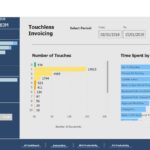Digital automation projects can be motivated by a number of factors – reducing payment cycles, increasing capture accuracy, or implementing e-invoicing. Chrome Consulting has delivered over 40 invoice automation projects globally, from which we have learned critical considerations when planning and deploying your automation project. Many expectations need to be aligned, and escalations can become emotional when supplier payments are delayed.
Be clear on the end-game before the games begin. As an enterprise, align and communicate your expectations around the different types of purchasing scenarios, as the processes are very different. For example, the purchase of services has a pattern that tends to be on-demand, where the costs are more unpredictable. Purchasing for stock/inventory has a ‘3-way match’ providing the required authorisation to pay based on a pre-agreed price. Finally, utility bills, which traditionally present complex, lengthy invoices, challenge the optical character recognition technologies and include a value that you normally have to pay. So plan your expenditure control and procurement processes with practicality and governance in mind.
Communicate the expectations around any change in purchasing behaviour to your staff. Invoice automation codifies your behaviour or rules, so if your organisation states we have a “no PO no pay” rule, then this must be enforced to change behaviours, and not ignored because it’s in the “too hard” basket. Note any deviations to the expected behaviour or process incurs re-work time, loss of control or loss of transparency. Secure your senior management’s buy-in from day one to ensure the business understands and adheres to your purchasing policies.
At project initiation, create a collaborative team between the supply chain and finance; this is a procure-to-pay (P2P) solution which spans these teams so the approach cannot be tackled in isolation. This integration pays dividends after go-live when issues have knock-on effects across the teams. Paying invoices is the overall goal, i.e. the “meat in the sandwich”, but it is not palatable without the bread and butter.
Based on over 40 P2P projects, suppliers want to be engaged and have a vested interest in your project’s success as their payments will be uninterrupted. Bring your critical suppliers on board early on into the planning and keep them informed of changes to policies, project progress and key dates. Our demo on P2P in the Modern Era shows how the supplier is potentially impacted by an invoice automation project spanning different SAP applications.
During the project design phase, ensure the high-volume invoice scenarios are communicated to your project team so they can focus on delivering largest benefit to the business, and do not expect the ‘one size to fit all’ approach.
End-user training is always rushed towards the conclusion of the project. In the context of P2P automation projects training is not about the usual keystrokes (as there should be few if any) but instead have a focus on understanding the causes of errors how they can be remediated quickly. Navigating comfortably across the different SAP functions such as purchasing and warehouse management is crucial to resolve issues quickly, a collaborative and informed team usually achieves this.
Now it’s time to talk about data! Do not underestimate the impact of your migrated/converted data on the success of your invoice processing capability. The invoice automation solution will refer to this data at scale for matching etc but it cannot post the invoice into ERP if the data is incorrect. The quality of master data, such as converted legacy purchase orders, cost objects, and system users is crucial to posting invoices successfully in your ERP system. At go-live, we have seen that over 90% of the failures preventing straight-through processing relate to errors in posting from incorrect data. Those invoices could never have been posted even if they were entered directly into your ERP system. It has nothing do with invoice automation solution and everything to do with data.
During Hyper-care, fast and accurate triage of support tickets is the critical factor once live. Avoid merging training issues, and ‘real’ system defects in the same incident queue as this creates confusion, impeding resolution. In real life, this will occur, so ensure your triage team have the right skills to analyse and sort the queue quickly.
Beyond hyper-care, continue to work with your Accounts Payable (AP) professionals to bed down the solution and continuously look for opportunities to improve further and expedite processing. As your AP team, become more comfortable with the solution, they will become the champions for more and more success.
The end-game is a stable platform built to the design’s scope and implemented with minimal disruption to your shared services team, the wider business community, and your suppliers.



